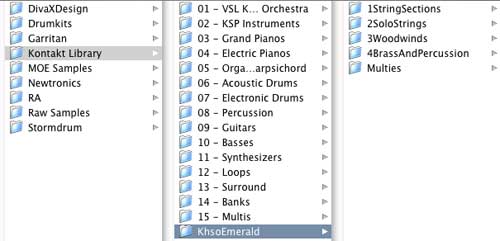Setup and Use
When running the numbers, a 20GB library for $325 might seem too good to be true. â€Å“Surely the samples can’t be good for that price.â€Â? Not so. â€Å“Well, then the programming can’t be that good…â€Â? Not so. â€Å“Okay, so what’s the catch?â€Â? I’m here to tell you: there is no catch. This library is simply an amazing value and is true to Kirk’s vision of creating a real ‘meat and potatoes’ library.
Assuming that you already have a copy of Kontakt or Gigastudio, the $325 price-tag completely betrays the actual value of this library. What you’ll get with KHSO Emerald are high quality samples, excellent programming (including keyswitches, modwheel x-fades, and a huge array of articulations) and a unique (read: not overused) sound palette that will add character and authenticity to your compositions.
Packaged as 4 DVDs of compressed RAR files, the KHSO Emerald library expands to approximately 20GB. Installation was fairly straightforward, though it did take some time – even on my-dual G5 Power Mac – to copy and decompress all the files.
The library is organized into 4 main folders: String Sections, Solo Strings, Woodwinds, and Brass and Percussion. Each of those folders then has a variety of subfolders which include the instrument samples, Kontakt instruments, impulse files (for Kontakt’s convolution reverb), and effects presets.

Once installed, I needed to rebuild my Kontakt database to recognize all the new instruments and presets. In addition, each time I loaded up a new instrument, I had to search for the associated sample files, since they were located in a different directory than that in which they were originally programmed. A small nuisance, but one that wasn’t mentioned in the documentation.
The documentation for the library is somewhat scattered at present. Each instrument folder has an associated RTF document that explains the various articulations and file abbreviations, as well as a short description of how each instrument might be used in a composition. Of special note are the instruments that were designed to be less taxing on CPU. Hunter takes care to explain how these instruments were made and which are the most efficient, which is helpful for users who are trying to keep a handle on systems that may balk at larger sample libraries.
Hunter has plans to compile the smaller, individual documents into a more comprehensive online or PDF manual. However, he is also working on some significant product updates that will require additional documentation (more on that later). As such, this ‘master manual’ will likely not be available until those updates are complete.
Next: How does it sound?